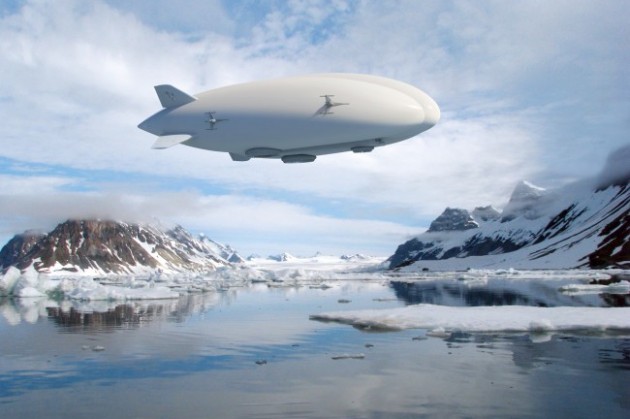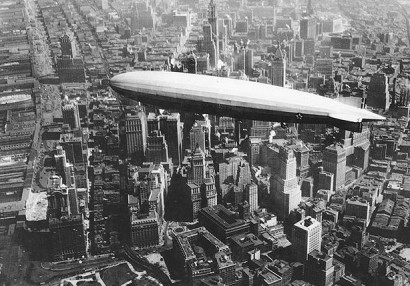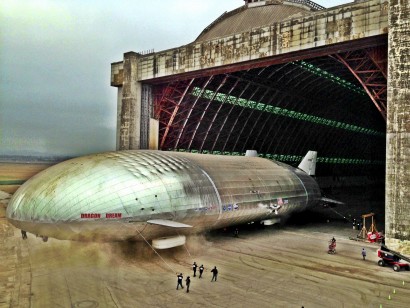
Prevailing winds: Canada’s infrastructure problem and the return of the Zeppelin
by David Kennedy, Online Reporter

The resurgence of an old technology could solve an issue that's plagued the Canadian Arctic for decades

Rendering of Lockheed Martin’s Hybrid Airship. The company has a fully-functional demonstrator and is currently pursuing buyers. It is designed to move cargo in remote areas. PHOTO: Lockheed Martin
WINNIPEG—Frost-bitten at the edge of Hudson’s Bay, 1,700 kilometres north of Winnipeg and about 100 kilometres shy of the Nunavut border, Churchill, Man. is best known as a prairie grain terminus and a hotspot for polar bears.
Like a number of other cities in Northern Canada, it’s also the end of the line—a sleepy town where the road north just ends.
To say Canada has an infrastructure problem understates the scale of the issue.
Nearly 70 per cent of the country’s landmass, or about seven million square kilometres, is inaccessible by major roads or rail lines. Some areas can be reached seasonally by ice roads or ships, but the rest rely on light air transport, essentially cutting them off from the modern North American economy. This lack of transportation makes the cost of goods in remote areas two-and-a-half to three-times as expensive as in the rest of Canada, and makes getting valuable resources out nearly impossible.
This logistical nightmare in Northern Canada and similar geographies around the world has specialists—and more than a few large companies—looking for a solution. And instead of clearing muskeg to build roads, or using innovative techniques to lay track on permafrost, some experts believe Zeppelins, or their modern day ancestors, can efficiently connect Canada’s scattered northern communities to the 21st century at a fraction of the cost.
“It’s been a long time in the wilderness… [but] the airship is finally finding itself a market,” Barry Prentice, a professor of supply chain management at the University of Manitoba, said in an interview.
The logistics expert and his fellow airship advocates are convinced the technology can not only be made safe, but that it could provide a cleantech solution to Canada’s persistent issues in the arctic.
Still, it will be a long way back for the “misunderstood” lighter-than-air flyer.
Though it’s been nearly 80 years since the iconic footage of the flaming Hindenburg was first broadcast across the world, the spectacular conflagration has never really faded from public memory.
Today, airships have all but disappeared; they’re more likely to be the butt of a joke about colossal engineering mishaps than to be seen anywhere outside an American football game.

USS Los Angeles docked over Manhattan in 1930. PHOTO: U.S. Naval Historical Center, via Wikimedia Commons
Nevertheless, there was a time when Zeppelins and other rigid and non-rigid airships were a relatively frequent sight. Through much of the ’30s, the technology was deadlocked with airplanes over which would become the dominant form of air transport.
“It isn’t that the technology didn’t work. The Germans took their Zeppelins from Brazil to Germany back and forth on a scheduled flight, and they never had an accident except for that famous one in New Jersey,” Prentice said.
The public was enamoured with the much faster, sleeker—and, at the time, seemingly less explosive—airplane. The age of airships ended before it truly got off the ground.
But a growing group of enthusiasts and some deep-pocketed investors are looking to update the out-of-style flyers.
Unlike their predecessors, modern airships are built to rigorous safety standards using state-of-the-art materials such as ultra-light aluminum and carbon fibre.
“The world’s moved forward a lot,” Prentice said. “[Our predecessors] had these old cow’s stomachs glued onto linen bath towels that contained the hydrogen. It’s almost laughable by today’s standards.”
While the safety benchmarks have evolved, new airships maintain the Zeppelins’ reputation for delivering weighty payloads. Worldwide Aeros Corp.’s Aeroscraft, for example, will be able to lift 66 tons. The rigid-structured airship is currently entering the early stages of production.
John Kiehle, the director of communications at Aeros said the 550-foot airship will be ideal for military logistics or heavy cargo operations.

Aeros’s Dragon Dream prototype. The scale model of the Aeroscraft will extend about 550 feet. PHOTO Aeros
“Whether it’s for shortening the Gantt chart, helping people access stranded resources on the commercial side, or it’s an ecological or humanitarian benefit, I think there really is quite a number of applications, especially up in the Canadian area,” he said.
Likewise, U.S. aerospace and defense company Lockheed Martin is developing a hybrid airship aimed at greatly improving supply chains in remote areas.
“These airships allow access to virtually anywhere, water or land, in wide range of weather conditions, without forward infrastructure or manpower required,” said Lockheed Martin Hybrid Airships program manager, Bob Boyd, adding that airships burn significantly less fuel than conventional planes.
To get off the ground, airships employ a lighter-than-air gas, which fills the vehicle’s envelopes, or cells. In most traditional airships, engines are only necessary to provide forward thrust. In Lockheed’s Hybrid Airship, gas provides 80 per cent of the lift, while aerodynamic and direct lift account for the other 20 per cent.
The Aeroscraft, meanwhile, employs a different approach altogether, and can make itself lighter or heavier than air on demand.
Regardless of how they generate lift, airships’ inherent buoyancy translates to significantly less fuel burned than traditional air transport.
Yet it’s the gas used to create a Zeppelin’s trademark lift that has most people feeling nervous. Today, there’s little cause for concern on that account.
The overwhelming majority of airships designed today—including the Aeroscraft and Lockheed’s Hybrid Airship—use non-reactive helium in place of the more combustible element at the opposite peak of the periodic table.
But it’s still a hot-button issue: Prentice contends hydrogen has long been the scapegoat for the structural failures that caused many of the early airship accidents.
“The Hindenburg, of course, is like a great big black mark over the whole hydrogen industry. And very unfairly, because again they don’t think it’s the hydrogen that actually caused the fire. Sure, it burned because it’s flammable, but it didn’t cause the fire,” he said.
Due to its abundance, and its ability to serve both as a lift agent and a fuel, Prentice thinks hydrogen still has a place. He pointed to the element’s flammability relative to gasoline as evidence that hydrogen can be used safely if handled properly. A four per cent concentration of hydrogen in the air is required to catch fire, while only a one per cent concentration of gasoline is needed, Prentice said.
“It’s very hard to get a four per cent concentration. It helps explain why all those old, leaky airships from 1900 to 1940 didn’t all catch fire… except when they crashed,” he said.
Perhaps the most significant benefit of using hydrogen in airships would be the opportunity to refuel in the north. Conventional aircraft flying into remote communities must carry enough fuel on-board to complete both legs of the trip, as they are unlikely to have access to aviation fuel once on the ground. Hydrogen, however, is relatively easy to synthesize and can easily be produced in remote communities using electrolysis. Airships would then be able to carry less fuel, allowing them to deliver heavier payloads.
Hydrogen also provides more inherent lift than helium—about six per cent more—according to Boyd.
Still, Lockheed elected to forego hydrogen in its airship design for several key reasons.
“It is a simple fact that hydrogen does combust, and once started it does so rather intensely,” Boyd said.
In addition to the risk to personnel, Boyd said using hydrogen would also carry a significant insurance premium over helium to cover the flammability issue. He anticipated higher safety standards being built into an airship as well, adding significantly to the overall cost and weight of the ship—both factors that would counteract hydrogen’s advantages.
“While pure science indicates that hydrogen is a better choice than helium, practicality points the opposite direction,” Boyd said.
Regardless of what companies may be using as a lift agent, for infrastructure-starved Northern Canada the important fact is airships are once again on the production line. The re-imagined technology from the 1930s offers to bring modernity to communities that may never see a road or rail line heading out of town.
